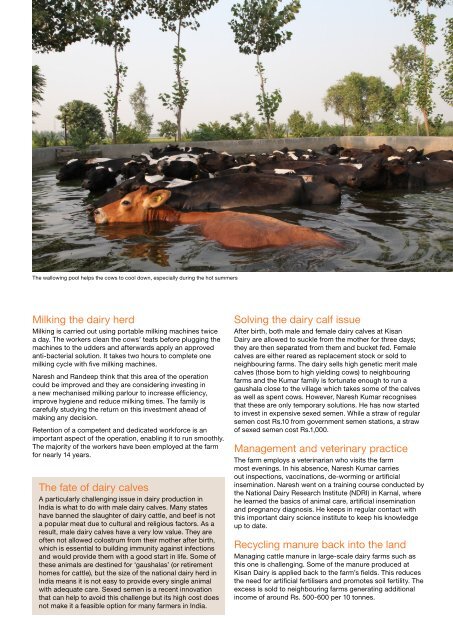High welfare milk production in India - WSPA
High welfare milk production in India - WSPA
High welfare milk production in India - WSPA
You also want an ePaper? Increase the reach of your titles
YUMPU automatically turns print PDFs into web optimized ePapers that Google loves.
The wallow<strong>in</strong>g pool helps the cows to cool down, especially dur<strong>in</strong>g the hot summers<br />
Milk<strong>in</strong>g the dairy herd<br />
Milk<strong>in</strong>g is carried out us<strong>in</strong>g portable <strong>milk</strong><strong>in</strong>g mach<strong>in</strong>es twice<br />
a day. The workers clean the cows’ teats before plugg<strong>in</strong>g the<br />
mach<strong>in</strong>es to the udders and afterwards apply an approved<br />
anti-bacterial solution. It takes two hours to complete one<br />
<strong>milk</strong><strong>in</strong>g cycle with five <strong>milk</strong><strong>in</strong>g mach<strong>in</strong>es.<br />
Naresh and Randeep th<strong>in</strong>k that this area of the operation<br />
could be improved and they are consider<strong>in</strong>g <strong>in</strong>vest<strong>in</strong>g <strong>in</strong><br />
a new mechanised <strong>milk</strong><strong>in</strong>g parlour to <strong>in</strong>crease efficiency,<br />
improve hygiene and reduce <strong>milk</strong><strong>in</strong>g times. The family is<br />
carefully study<strong>in</strong>g the return on this <strong>in</strong>vestment ahead of<br />
mak<strong>in</strong>g any decision.<br />
Retention of a competent and dedicated workforce is an<br />
important aspect of the operation, enabl<strong>in</strong>g it to run smoothly.<br />
The majority of the workers have been employed at the farm<br />
for nearly 14 years.<br />
The fate of dairy calves<br />
A particularly challeng<strong>in</strong>g issue <strong>in</strong> dairy <strong>production</strong> <strong>in</strong><br />
<strong>India</strong> is what to do with male dairy calves. Many states<br />
have banned the slaughter of dairy cattle, and beef is not<br />
a popular meat due to cultural and religious factors. As a<br />
result, male dairy calves have a very low value. They are<br />
often not allowed colostrum from their mother after birth,<br />
which is essential to build<strong>in</strong>g immunity aga<strong>in</strong>st <strong>in</strong>fections<br />
and would provide them with a good start <strong>in</strong> life. Some of<br />
these animals are dest<strong>in</strong>ed for ‘gaushalas’ (or retirement<br />
homes for cattle), but the size of the national dairy herd <strong>in</strong><br />
<strong>India</strong> means it is not easy to provide every s<strong>in</strong>gle animal<br />
with adequate care. Sexed semen is a recent <strong>in</strong>novation<br />
that can help to avoid this challenge but its high cost does<br />
not make it a feasible option for many farmers <strong>in</strong> <strong>India</strong>.<br />
Solv<strong>in</strong>g the dairy calf issue<br />
After birth, both male and female dairy calves at Kisan<br />
Dairy are allowed to suckle from the mother for three days;<br />
they are then separated from them and bucket fed. Female<br />
calves are either reared as replacement stock or sold to<br />
neighbour<strong>in</strong>g farms. The dairy sells high genetic merit male<br />
calves (those born to high yield<strong>in</strong>g cows) to neighbour<strong>in</strong>g<br />
farms and the Kumar family is fortunate enough to run a<br />
gaushala close to the village which takes some of the calves<br />
as well as spent cows. However, Naresh Kumar recognises<br />
that these are only temporary solutions. He has now started<br />
to <strong>in</strong>vest <strong>in</strong> expensive sexed semen. While a straw of regular<br />
semen cost Rs.10 from government semen stations, a straw<br />
of sexed semen cost Rs.1,000.<br />
Management and veter<strong>in</strong>ary practice<br />
The farm employs a veter<strong>in</strong>arian who visits the farm<br />
most even<strong>in</strong>gs. In his absence, Naresh Kumar carries<br />
out <strong>in</strong>spections, vacc<strong>in</strong>ations, de-worm<strong>in</strong>g or artificial<br />
<strong>in</strong>sem<strong>in</strong>ation. Naresh went on a tra<strong>in</strong><strong>in</strong>g course conducted by<br />
the National Dairy Research Institute (NDRI) <strong>in</strong> Karnal, where<br />
he learned the basics of animal care, artificial <strong>in</strong>sem<strong>in</strong>ation<br />
and pregnancy diagnosis. He keeps <strong>in</strong> regular contact with<br />
this important dairy science <strong>in</strong>stitute to keep his knowledge<br />
up to date.<br />
Recycl<strong>in</strong>g manure back <strong>in</strong>to the land<br />
Manag<strong>in</strong>g cattle manure <strong>in</strong> large-scale dairy farms such as<br />
this one is challeng<strong>in</strong>g. Some of the manure produced at<br />
Kisan Dairy is applied back to the farm’s fields. This reduces<br />
the need for artificial fertilisers and promotes soil fertility. The<br />
excess is sold to neighbour<strong>in</strong>g farms generat<strong>in</strong>g additional<br />
<strong>in</strong>come of around Rs. 500-600 per 10 tonnes.

















